PFAS Thyroid Disease Lawsuit
- Last Updated: July 14th, 2025

Attorney Jessica Paluch-Hoerman, founder of TruLaw, has over 28 years of experience as a personal injury and mass tort attorney, and previously worked as an international tax attorney at Deloitte. Jessie collaborates with attorneys nationwide — enabling her to share reliable, up-to-date legal information with our readers.
Legally Reviewed
This article has been written and reviewed for legal accuracy and clarity by the team of writers and legal experts at TruLaw and is as accurate as possible. This content should not be taken as legal advice from an attorney. If you would like to learn more about our owner and experienced injury lawyer, Jessie Paluch, you can do so here.
Fact-Checked
TruLaw does everything possible to make sure the information in this article is up to date and accurate. If you need specific legal advice about your case, contact us by using the chat on the bottom of this page. This article should not be taken as advice from an attorney.
Key takeaways:
- The PFAS thyroid disease lawsuit seeks compensation for individuals who developed thyroid issues due to exposure to PFAS chemicals.
- Studies show that PFAS chemicals can interfere with thyroid hormone production and regulation, increasing the risk of hypothyroidism, hyperthyroidism, and autoimmune thyroid disorders.
- The EPA and state governments have taken actions to address PFAS risks, including setting drinking water standards, phasing out PFAS use in certain products, and investing in research for safer alternatives.
Overview of the PFAS Thyroid Disease Lawsuit
On this page, we’ll provide an overview of the PFAS Thyroid Disease Lawsuit, PFAS lawsuit consolidation and court proceedings, health impacts of PFAS exposure on the thyroid, and much more.
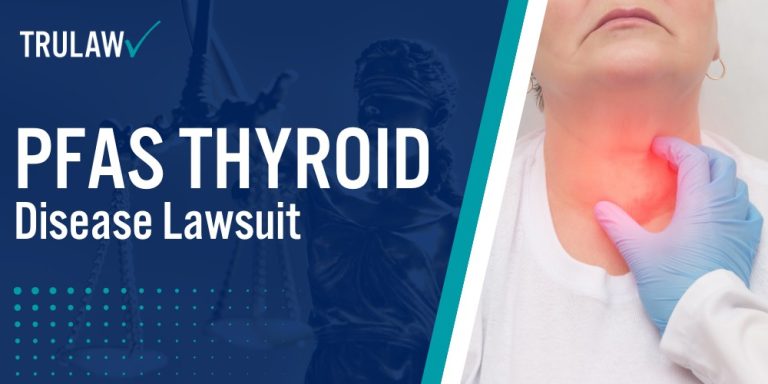
Intro to the PFAS Thyroid Disease Lawsuit
Key aspects of the PFAS thyroid disease lawsuit include:
- Plaintiffs allege that manufacturers knowingly produced and released PFAS chemicals, leading to widespread contamination and adverse health effects like thyroid disease
- The lawsuit seeks compensation for those affected by PFAS-related thyroid issues, including military personnel, firefighters, and residents near contaminated sites
- Attorneys are employing legal strategies like establishing causal links between PFAS and thyroid dysfunction and tracing contamination back to manufacturers
If you or a loved one has developed thyroid disease or other health issues after being exposed to PFAS chemicals, you may be eligible to pursue compensation.
Contact TruLaw using the chat on this page for a free case evaluation to see if you qualify to file a PFAS thyroid disease lawsuit today.
Table of Contents
Legal Developments in the PFAS Thyroid Disease Lawsuit
The PFAS thyroid disease lawsuit has gained significant momentum in recent years, as affected individuals seek compensation for thyroid issues linked to PFAS exposure.
Plaintiffs allege that manufacturers knowingly produced and released PFAS chemicals, leading to widespread contamination and adverse health effects, including thyroid disease.
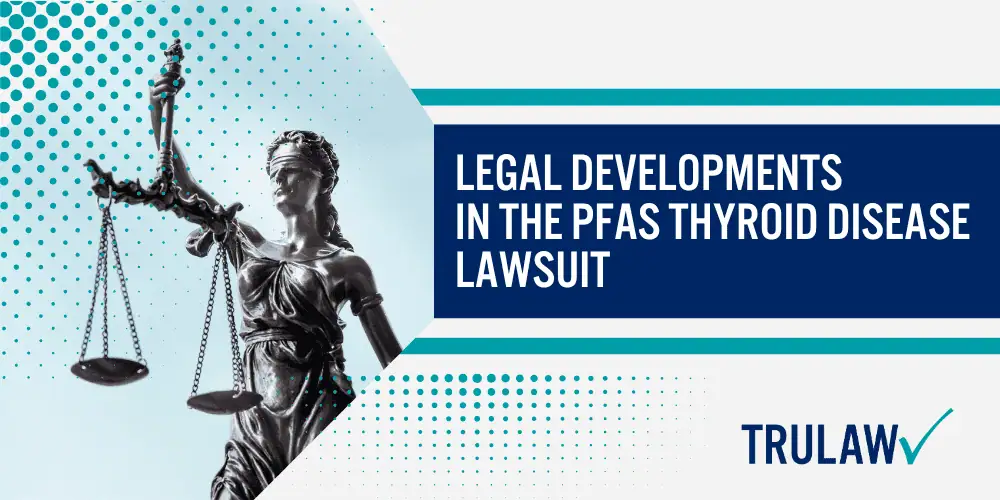
As the lawsuit progresses, legal strategies employed by plaintiffs’ attorneys aim to establish a clear connection between PFAS exposure and thyroid dysfunction.
Plaintiffs Pursue Compensation for PFAS-Related Thyroid Issues
Individuals diagnosed with thyroid disease after exposure to PFAS chemicals are pursuing compensation through the PFAS thyroid disease lawsuit.
Plaintiffs argue that manufacturers should be held accountable for the health consequences of PFAS contamination, including medical expenses, lost wages, and pain and suffering associated with thyroid disorders.
The lawsuit seeks to provide relief for those affected by PFAS-related thyroid issues and ensure that manufacturers take responsibility for their actions.
The PFAS thyroid disease lawsuit encompasses a wide range of plaintiffs, including military personnel, firefighters, and residents of communities near PFAS-contaminated sites.
These individuals have been exposed to PFAS through various means, such as drinking contaminated water, using PFAS-containing products, or working with PFAS in occupational settings.
Key Legal Strategies Employed in PFAS Thyroid Disease Cases
Attorneys representing plaintiffs in the PFAS thyroid disease lawsuit are employing various legal strategies to strengthen their cases.
These strategies include gathering extensive scientific evidence linking PFAS exposure to thyroid dysfunction, identifying specific sources of PFAS contamination, and demonstrating the manufacturers’ knowledge of the risks associated with these chemicals.
By building strong cases based on scientific evidence and legal arguments, plaintiffs aim to secure favorable outcomes and obtain the compensation they deserve.
One key strategy involves establishing the causal link between PFAS exposure and thyroid disease.
Plaintiffs’ attorneys work closely with medical experts and researchers to present compelling evidence that demonstrates the detrimental effects of PFAS on thyroid function.
This evidence includes epidemiological studies, animal studies, and mechanistic data that show how PFAS chemicals interfere with thyroid hormone production and regulation.
Another important strategy focuses on identifying the specific sources of PFAS contamination and tracing them back to the manufacturers.
Attorneys investigate the history of PFAS production, use, and disposal to establish the culpability of the defendants.
This process involves examining internal company documents, conducting interviews with former employees, and analyzing environmental data to determine the extent and duration of PFAS contamination.
Scientific Evidence Supporting the PFAS Thyroid Disease Lawsuit
The PFAS thyroid disease lawsuit relies heavily on scientific evidence to establish the connection between PFAS exposure and thyroid disorders.
Numerous studies have investigated the impact of PFAS chemicals on thyroid function, providing a solid foundation for the claims made by plaintiffs.
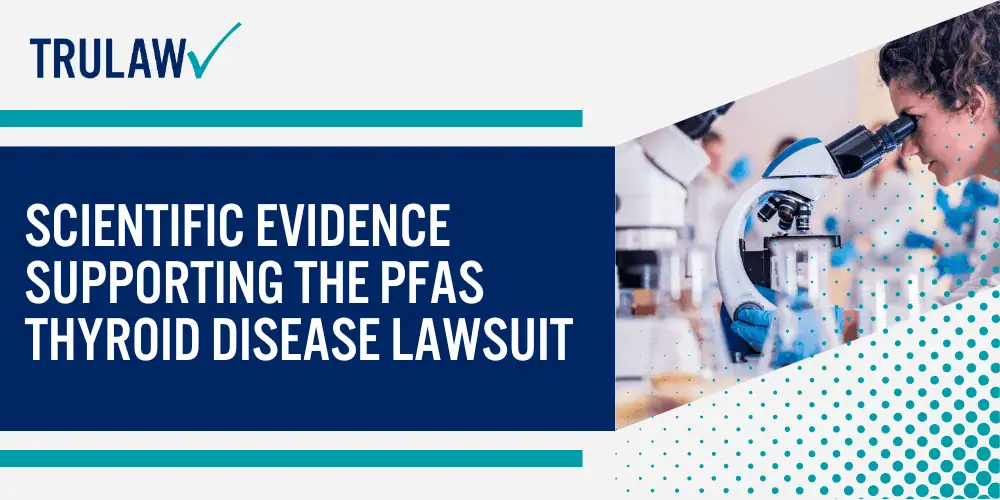
Expert testimonies from medical professionals and researchers further strengthen the scientific basis of the lawsuit, highlighting the detrimental effects of PFAS on thyroid health.
Research Connecting PFAS Exposure to Thyroid Disease
A growing body of research has identified a link between PFAS exposure and an increased risk of developing thyroid disease.
Studies have shown that PFAS chemicals can interfere with thyroid hormone production and regulation, leading to conditions such as hypothyroidism, hyperthyroidism, and autoimmune thyroid disorders.
This research provides crucial evidence to support the claims made by plaintiffs in the PFAS thyroid disease lawsuit, demonstrating the causal relationship between PFAS exposure and thyroid dysfunction.
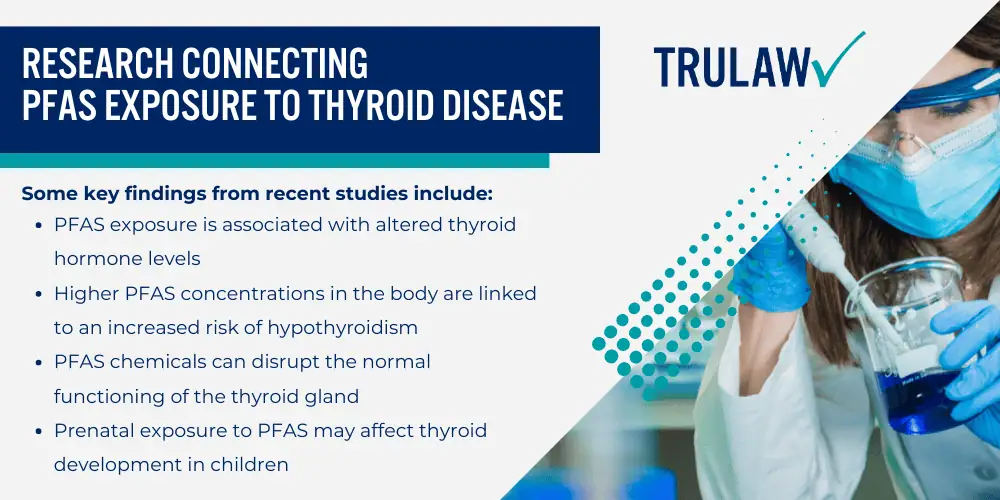
Some key findings from recent studies include:
- PFAS exposure is associated with altered thyroid hormone levels
- Higher PFAS concentrations in the body are linked to an increased risk of hypothyroidism
- PFAS chemicals can disrupt the normal functioning of the thyroid gland
- Prenatal exposure to PFAS may affect thyroid development in children
These studies have been conducted on various populations, including occupationally exposed workers, communities living near PFAS-contaminated sites, and the general population.
The consistent findings across different study designs and populations strengthen the evidence linking PFAS exposure to thyroid disease.
Expert Testimonies Strengthen PFAS Thyroid Disease Claims
In addition to scientific research, expert testimonies play a vital role in strengthening the claims made in the PFAS thyroid disease lawsuit.
Medical professionals, toxicologists, and environmental scientists provide valuable insights into the mechanisms by which PFAS chemicals harm thyroid function.
Their testimonies help establish the credibility of the scientific evidence and provide a clear understanding of the serious health problems and consequences associated with PFAS exposure.
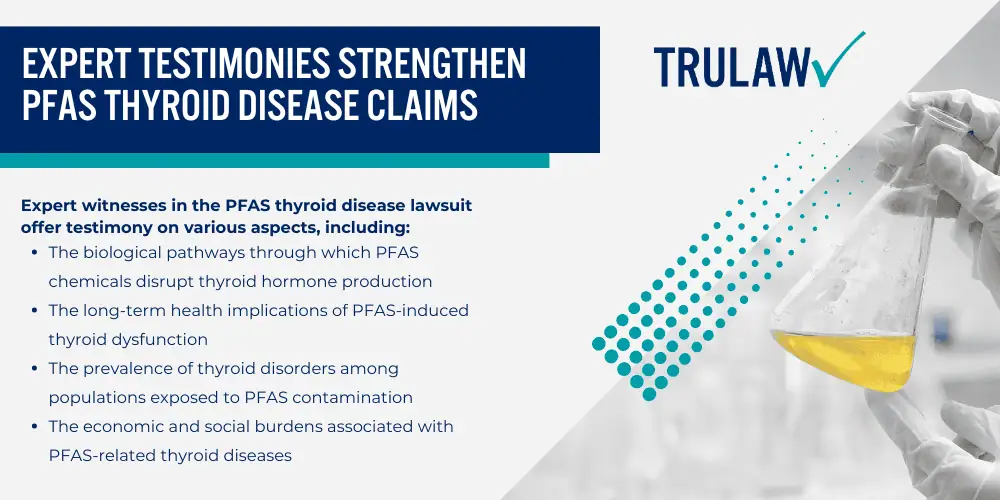
Expert witnesses in the PFAS thyroid disease lawsuit offer testimony on various aspects, including:
- The biological pathways through which PFAS chemicals disrupt thyroid hormone production
- The long-term health implications of PFAS-induced thyroid dysfunction
- The prevalence of thyroid disorders among populations exposed to PFAS contamination
- The economic and social burdens associated with PFAS-related thyroid diseases
These expert testimonies are crucial in translating complex scientific concepts into understandable terms for judges, juries, and the public.
They help build a compelling case that demonstrates the causal link between PFAS exposure and thyroid disease and underscore the need for accountability and compensation.
PFAS Lawsuit Consolidation and Court Proceedings
As the number of PFAS thyroid disease lawsuits continues to grow, courts have taken steps to streamline the legal process and ensure efficient resolution of cases.
One key strategy is the consolidation of PFAS lawsuits into multidistrict litigation (MDL) or state-level coordinated proceedings.
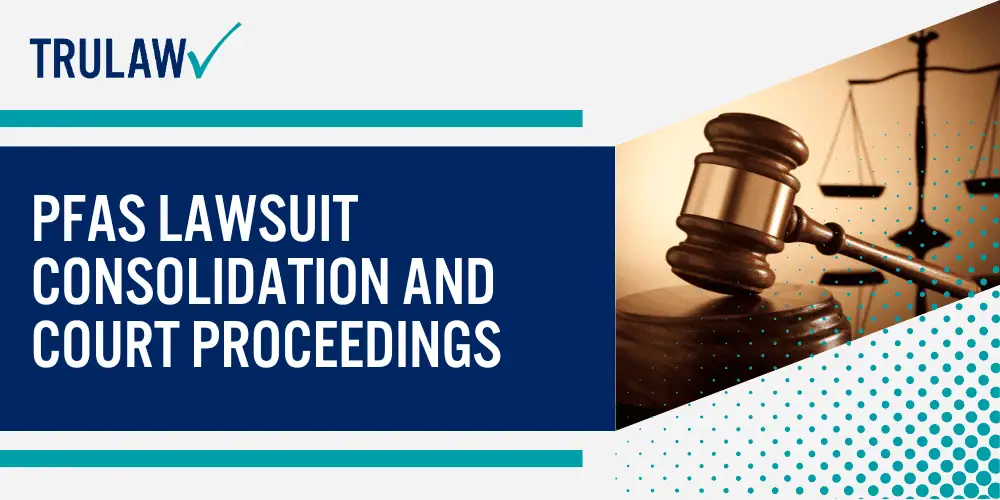
This approach allows for the centralization of similar cases, sharing of resources, and consistent rulings across jurisdictions.
Judicial Efficiency through PFAS Case Consolidation
The consolidation of PFAS thyroid disease lawsuits into MDLs or coordinated proceedings offers several benefits for both plaintiffs and the judicial system.
By grouping similar cases together, courts can avoid duplicative discovery processes, inconsistent rulings, and unnecessary delays.
This streamlined approach allows for a more efficient resolution of PFAS cases, saving time and resources for all parties involved.
In an MDL, a single judge oversees the pretrial proceedings, including discovery, motion practice, and settlement negotiations.
This centralized management ensures consistent rulings and facilitates the exchange of information among plaintiffs’ attorneys.
The MDL process also allows for the selection of representative cases, known as bellwether trials, which help gauge the strength of the personal injury claims and inform potential settlement discussions.
Bellwether Trials in PFAS Thyroid Disease Litigation
Bellwether trials play a crucial role in PFAS thyroid disease litigation, as they provide insight into how juries may respond to the evidence presented and the arguments made by both sides.
These trials involve a small number of representative cases selected from the larger pool of consolidated lawsuits.
The outcomes of bellwether trials can significantly influence the trajectory of the litigation and the willingness of defendants to settle.
In the context of PFAS thyroid disease lawsuits, bellwether trials allow plaintiffs’ attorneys to present their strongest cases, showcasing the scientific evidence and expert testimonies that support the link between PFAS exposure and thyroid dysfunction.
Successful bellwether trials can put pressure on defendants to negotiate favorable settlement terms, as they face the prospect of numerous similar cases moving forward with potentially substantial damages.
The results of bellwether trials also provide valuable information for plaintiffs who are considering joining the lawsuit or pursuing individual claims.
Positive outcomes can encourage more affected individuals to come forward and seek compensation for their PFAS-related thyroid issues.
Health Impacts of PFAS Exposure on the Thyroid
The PFAS thyroid disease lawsuit highlights the severe health consequences associated with PFAS exposure, particularly the impact on thyroid function.
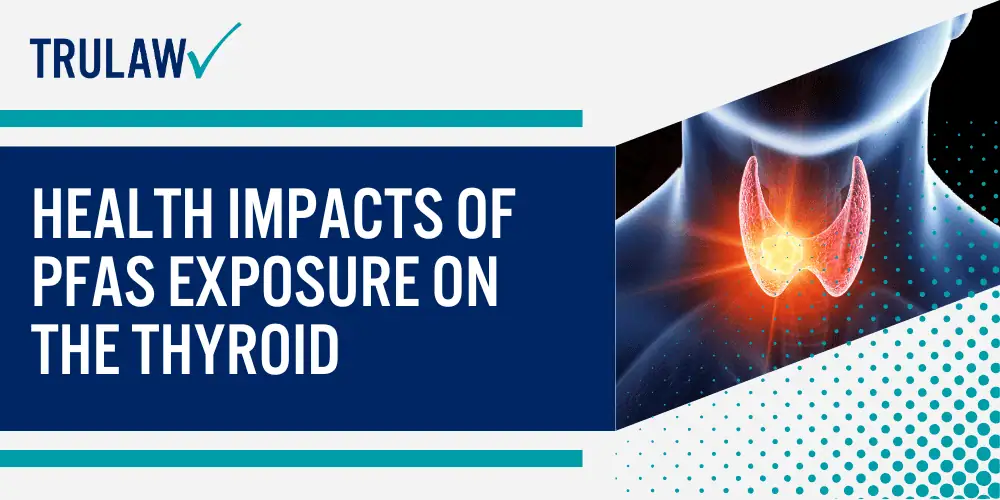
The thyroid gland plays a critical role in regulating metabolism, growth, and development, and any disruption to its normal functioning can lead to a wide range of adverse health effects.
PFAS Interference with Thyroid Hormone Production
PFAS chemicals have been shown to interfere with the production and regulation of thyroid hormones, which are essential for maintaining proper bodily functions.
These chemicals can disrupt the delicate balance of the thyroid system through various mechanisms, including:
- Inhibiting the uptake of iodine, a crucial component in thyroid hormone synthesis
- Altering the expression of genes involved in thyroid hormone production
- Competing with thyroid hormones for binding sites on transport proteins
- Increasing the metabolism and elimination of thyroid hormones
These disruptions can lead to a range of thyroid disorders, including hypothyroidism (underactive thyroid), hyperthyroidism (overactive thyroid), and autoimmune thyroid conditions such as Hashimoto’s thyroiditis and Graves’ disease.
Long-Term Health Consequences of PFAS-Induced Thyroid Disease
The health consequences of PFAS-induced thyroid disease can be far-reaching and long-lasting.
Thyroid dysfunction can affect nearly every system in the body, leading to a wide range of symptoms and complications.
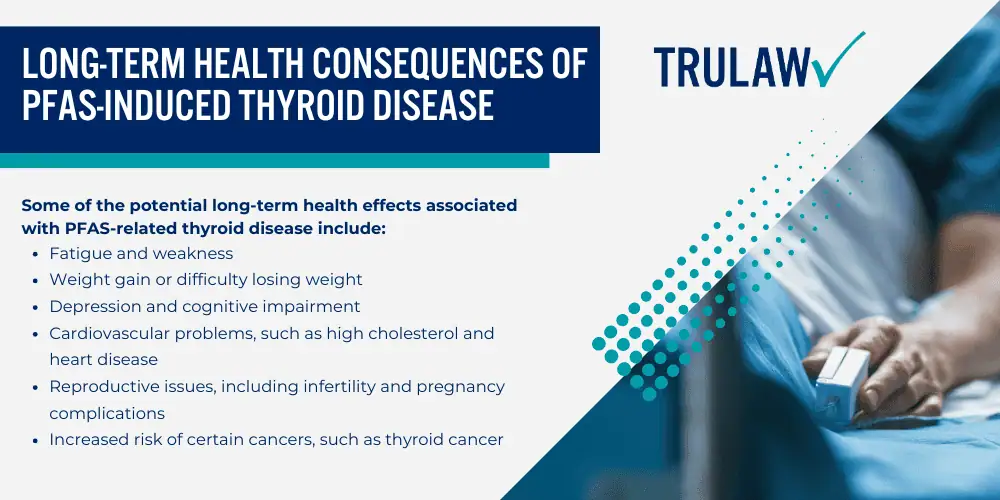
Some of the potential long-term health effects associated with PFAS-related thyroid disease include:
- Fatigue and weakness
- Weight gain or difficulty losing weight
- Depression and cognitive impairment
- Cardiovascular problems, such as high cholesterol and heart disease
- Reproductive issues, including infertility and pregnancy complications
- Increased risk of certain cancers, such as thyroid cancer
These health consequences can significantly impact an individual’s quality of life, ability to work, and overall well-being.
The PFAS thyroid disease lawsuit seeks to address these long-term effects by providing compensation for medical expenses, lost wages, and pain and suffering associated with PFAS-induced thyroid disorders.
Regulatory and Governmental Response to PFAS Exposure
As the scientific evidence linking PFAS exposure to adverse health effects, including thyroid disease, continues to mount, regulatory agencies and governments at both the federal and state levels have taken steps to address the risks associated with these chemicals.
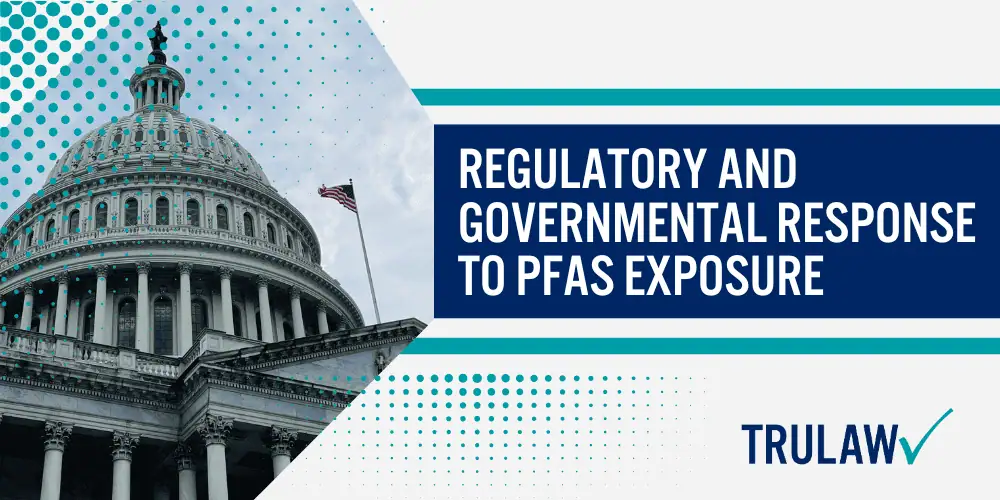
EPA and State-Level Actions Addressing PFAS Risks
The United States Environmental Protection Agency (EPA) has recognized that individuals who pose significant health risks associated with PFAS exposure and has taken several actions to address these concerns.
In 2016, the EPA established health advisories for two common PFAS chemicals, perfluorooctanoic acid (PFOA) and perfluorooctane sulfonic acid (PFOS), setting a combined limit of 70 parts per trillion in drinking water.
In addition to federal efforts, many states have implemented their own regulations and guidelines related to PFAS.
Some states, such as Michigan, New Jersey, and New Hampshire, have set more stringent drinking water standards for PFAS chemicals, recognizing the need for greater protection of public health.
State attorneys general have also played a crucial role in addressing PFAS contamination and holding manufacturers accountable.
Several states, including Minnesota, New York, and Ohio, have filed lawsuits against PFAS manufacturers, seeking damages for the environmental and health consequences of PFAS contamination.
Government Initiatives to Limit PFAS Contamination
Governments at various levels have implemented initiatives to limit PFAS contamination and protect public health.
These efforts include, but are not limited to:
- Phasing out the use of PFAS in certain products, such as food packaging and firefighting foam
- Investing in research to develop safer alternatives to PFAS chemicals
- Establishing monitoring programs to detect PFAS contamination in drinking water and the environment
- Providing funding for cleanup efforts in PFAS-contaminated communities
These government actions demonstrate a growing recognition of the risks associated with PFAS exposure and the need for proactive measures to address this public health crisis.
As the scientific understanding of PFAS continues to evolve, it is expected that regulatory and governmental responses will adapt to better protect the health of individuals and communities affected by these forever chemicals.
Settlements and Compensation in PFAS Thyroid Disease Cases
As the PFAS thyroid disease lawsuit progresses, settlements and compensation for affected individuals have become a focal point of discussion.
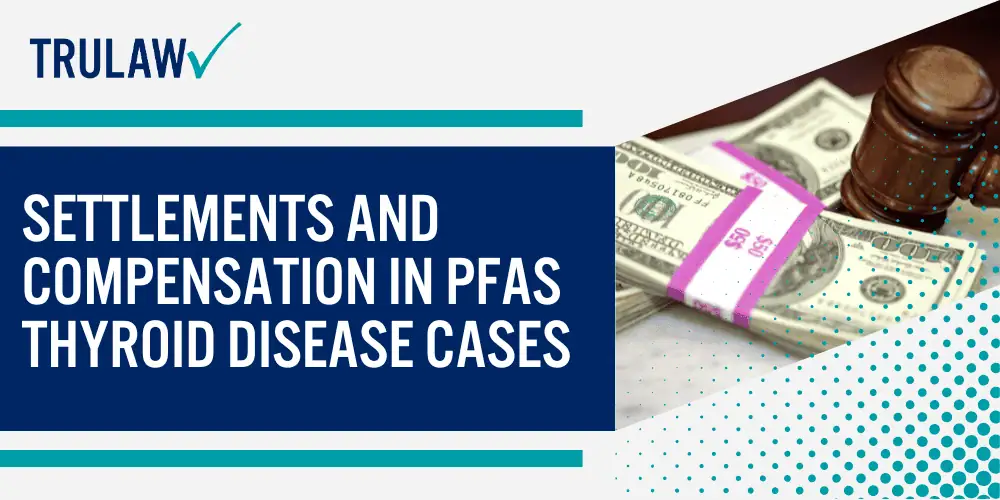
Recent settlements in PFAS-related cases have set important precedents and provide insight into the potential outcomes for plaintiffs seeking compensation for their thyroid issues.
Potential Compensation for PFAS-Affected Individuals
Individuals affected by PFAS-related thyroid disease may be eligible for various forms of compensation, depending on the specific circumstances of their case.
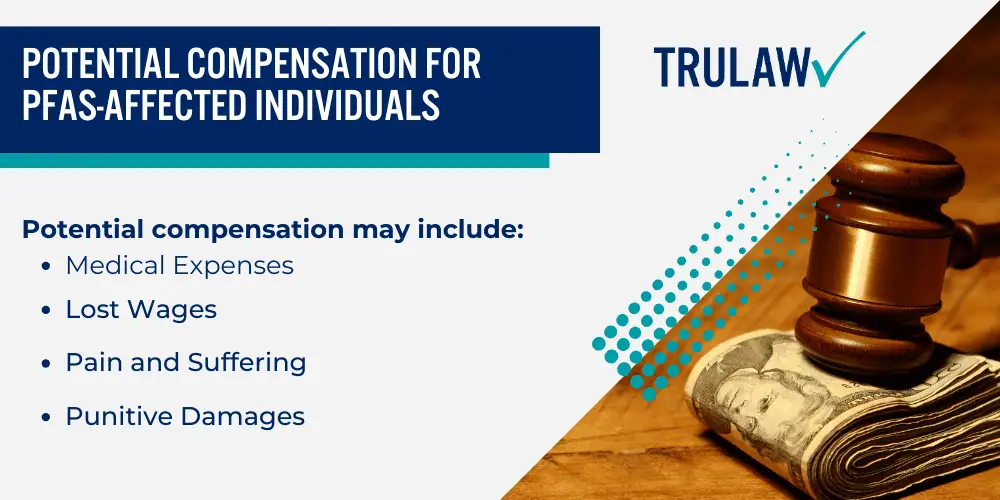
Potential compensation may include:
- Medical Expenses: Compensation for past, present, and future medical costs associated with PFAS-induced thyroid disease, including diagnostic tests, treatments, medications, and surgeries.
- Lost Wages: Compensation for income lost due to the inability to work or reduced earning capacity resulting from PFAS-related thyroid issues.
- Pain and Suffering: Compensation for the physical and emotional distress caused by PFAS-induced thyroid disease, including the impact on quality of life and relationships.
- Punitive Damages: In some cases, courts may award punitive damages to punish defendants for particularly egregious conduct and deter future misconduct.
The amount of compensation awarded in PFAS thyroid disease cases will depend on factors such as the severity of the health effects, the strength of the evidence linking PFAS exposure to thyroid dysfunction, and the specific legal strategies employed by the law firm.
As more cases are resolved through settlements or verdicts, a clearer picture of the potential compensation for PFAS-affected individuals will emerge.
Recent PFAS Thyroid Disease Settlements and Their Implications
In 2021, a landmark settlement was reached in the PFAS multidistrict litigation (MDL) involving DuPont and its spinoff company, Chemours.
The settlement, valued at over $4 billion, included provisions for compensation to individuals who suffered from PFAS-related health conditions, including thyroid disease.
This settlement demonstrated the potential for significant compensation for plaintiffs in PFAS thyroid disease cases and set the stage for future negotiations.
Other notable PFAS settlements have been reached at the state level.
For example, in 2018, the state of Minnesota reached a settlement with 3M for $850 million to address PFAS contamination in the state’s drinking water.
While this settlement focused primarily on environmental remediation, it also included provisions for studying the health effects of PFAS exposure and supporting affected communities.
These settlements highlight the increasing recognition of the harm caused by PFAS exposure and the willingness of defendants to negotiate substantial compensation for affected individuals.
As more PFAS thyroid disease cases move through the legal system, these precedents will likely influence future settlement discussions and outcomes.
Broader Implications of the PFAS Thyroid Disease Lawsuit
The PFAS thyroid disease lawsuit has far-reaching implications beyond the specific health effects and compensation for affected individuals.
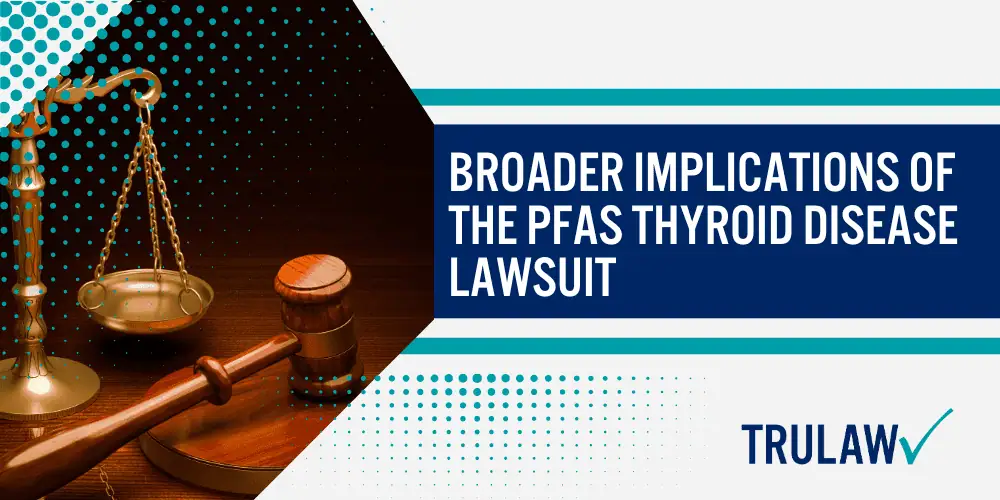
This litigation has the potential to shape industry practices, influence environmental policies, and raise public awareness about the risks associated with PFAS exposure.
Industry Response to PFAS Litigation and Thyroid Health Risks
The PFAS thyroid disease lawsuit has put significant pressure on industries that manufacture or use PFAS chemicals.
As the scientific evidence linking PFAS exposure to thyroid dysfunction continues to grow, companies are facing increased scrutiny and potential liability for their role in PFAS contamination.
In response to this litigation and the associated risks, some companies have taken proactive steps to phase out the use of PFAS in their products and processes.
Others have invested in the development of safer alternatives to PFAS chemicals, recognizing the need to address public health concerns and mitigate legal liabilities.
The PFAS thyroid disease lawsuit has also prompted greater transparency and disclosure from companies regarding their use of PFAS chemicals.
As consumers become more aware of the potential health risks associated with PFAS exposure, they are increasingly demanding information about the presence of these chemicals in the products they use and the environmental impact of their production.
Impact of PFAS Lawsuits on Future Environmental Policies
The PFAS thyroid disease lawsuit, along with other PFAS-related litigation, has the potential to drive significant changes in environmental policies and regulations.
As the health and economic consequences of PFAS contamination become more apparent, policymakers are facing increased pressure to take action to protect public health and the environment.
The outcomes of PFAS lawsuits may influence the development of more stringent regulations and guidelines related to the production, use, and disposal of PFAS chemicals.
This could include setting lower permissible levels of PFAS in drinking water, mandating the phase-out of PFAS in certain products, and requiring more extensive monitoring and reporting of PFAS contamination.
The PFAS thyroid disease lawsuit may also spur greater investment in research to better understand the health effects of PFAS exposure and develop effective methods for remediation and treatment.
As the scientific knowledge base expands, policymakers will be better equipped to make informed decisions about how to address the PFAS crisis and protect public health.
Ultimately, the PFAS thyroid disease lawsuit serves as a catalyst for broader changes in how we approach the regulation and management of toxic chemicals in our environment.
By holding manufacturers accountable for the harm caused by PFAS and raising public awareness about the risks associated with these chemicals, this litigation has the potential to drive meaningful reforms and protect the health of current and future generations.
PFAS Contamination Lawsuit Frequently Asked Questions
-
The PFAS thyroid disease lawsuit seeks compensation for individuals who develop thyroid disorders after exposure to PFAS chemicals.
Plaintiffs allege that manufacturers knowingly produced and released PFAS, leading to widespread contamination and adverse health effects.
-
PFAS chemicals can interfere with the production and regulation of thyroid hormones, which are essential for maintaining proper bodily functions.
This disruption can lead to a range of thyroid disorders, including hypothyroidism, hyperthyroidism, and autoimmune thyroid conditions.
-
The health consequences of PFAS-induced thyroid disease can be far-reaching and long-lasting, affecting nearly every system in the body.
Potential long-term effects include fatigue, weight gain, depression, cardiovascular problems, reproductive issues, and an increased risk of certain cancers.
-
Courts have taken steps to streamline the legal process by consolidating PFAS lawsuits into multidistrict litigation (MDL) or state-level coordinated proceedings.
This approach allows for the centralization of similar cases, sharing of resources, and consistent rulings across jurisdictions.
-
Individuals affected by PFAS-related thyroid disease may be eligible for various forms of compensation, including coverage for medical expenses, lost wages, pain and suffering, and in some cases, punitive damages.
The specific compensation will depend on factors such as the severity of the health effects and the strength of the evidence linking PFAS exposure to thyroid dysfunction.

Managing Attorney & Owner
With over 25 years of legal experience, Jessica Paluch-Hoerman is an Illinois lawyer, a CPA, and a mother of three. She spent the first decade of her career working as an international tax attorney at Deloitte.
In 2009, Jessie co-founded her own law firm with her husband – which has scaled to over 30 employees since its conception.
In 2016, Jessie founded TruLaw, which allows her to collaborate with attorneys and legal experts across the United States on a daily basis. This hypervaluable network of experts is what enables her to share the most reliable, accurate, and up-to-date legal information with our readers!
Additional PFAS Contamination Lawsuit resources on our website:
Here, at TruLaw, we’re committed to helping victims get the justice they deserve.
Alongside our partner law firms, we have successfully collected over $3 Billion in verdicts and settlements on behalf of injured individuals.
Would you like our help?
At TruLaw, we fiercely combat corporations that endanger individuals’ well-being. If you’ve suffered injuries and believe these well-funded entities should be held accountable, we’re here for you.
With TruLaw, you gain access to successful and seasoned lawyers who maximize your chances of success. Our lawyers invest in you—they do not receive a dime until your lawsuit reaches a successful resolution!
AFFF Lawsuit claims are being filed against manufacturers of aqueous film-forming foam (AFFF), commonly used in firefighting.
Claims allege that companies such as 3M, DuPont, and Tyco Fire Products failed to adequately warn users about the potential dangers of AFFF exposure — including increased risks of various cancers and diseases.
Depo Provera Lawsuit claims are being filed by individuals who allege they developed meningioma (a type of brain tumor) after receiving Depo-Provera birth control injections.
A 2024 study found that women using Depo-Provera for at least 1 year are five times more likely to develop meningioma brain tumors compared to those not using the drug.
Suboxone Tooth Decay Lawsuit claims are being filed against Indivior, the manufacturer of Suboxone, a medication used to treat opioid addiction.
Claims allege that Indivior failed to adequately warn users about the potential dangers of severe tooth decay and dental injuries associated with Suboxone’s sublingual film version.
Social Media Harm Lawsuits are being filed against social media companies for allegedly causing mental health issues in children and teens.
Claims allege that companies like Meta, Google, ByteDance, and Snap designed addictive platforms that led to anxiety, depression, and other mental health issues without adequately warning users or parents.
Transvaginal Mesh Lawsuits are being filed against manufacturers of transvaginal mesh products used to treat pelvic organ prolapse (POP) and stress urinary incontinence (SUI).
Claims allege that companies like Ethicon, C.R. Bard, and Boston Scientific failed to adequately warn about potential dangers — including erosion, pain, and infection.
Bair Hugger Warming Blanket Lawsuits involve claims against 3M — alleging their surgical warming blankets caused severe infections and complications (particularly in hip and knee replacement surgeries).
Plaintiffs claim 3M failed to warn about potential risks — despite knowing about increased risk of deep joint infections since 2011.
Baby Formula NEC Lawsuit claims are being filed against manufacturers of cow’s milk-based baby formula products.
Claims allege that companies like Abbott Laboratories (Similac) and Mead Johnson & Company (Enfamil) failed to warn about the increased risk of necrotizing enterocolitis (NEC) in premature infants.
Here, at TruLaw, we’re committed to helping victims get the justice they deserve.
Alongside our partner law firms, we have successfully collected over $3 Billion in verdicts and settlements on behalf of injured individuals.
Would you like our help?

